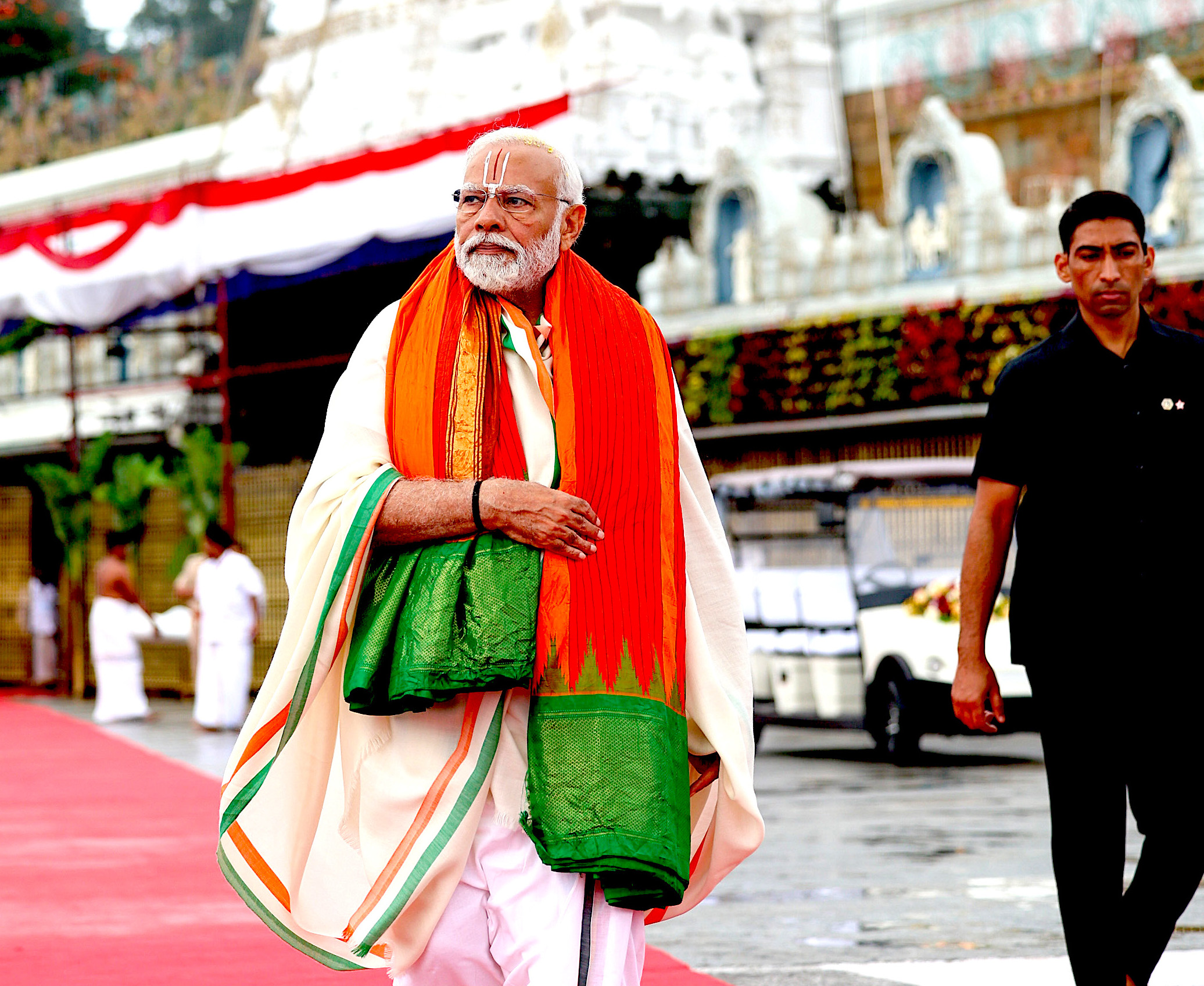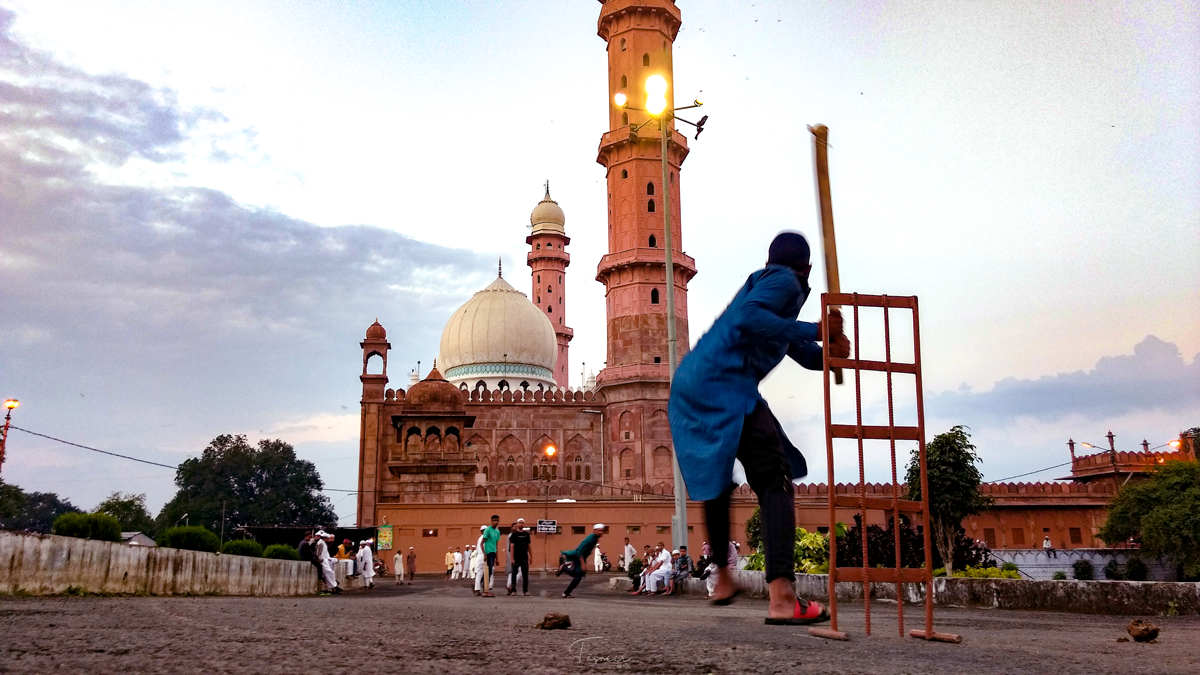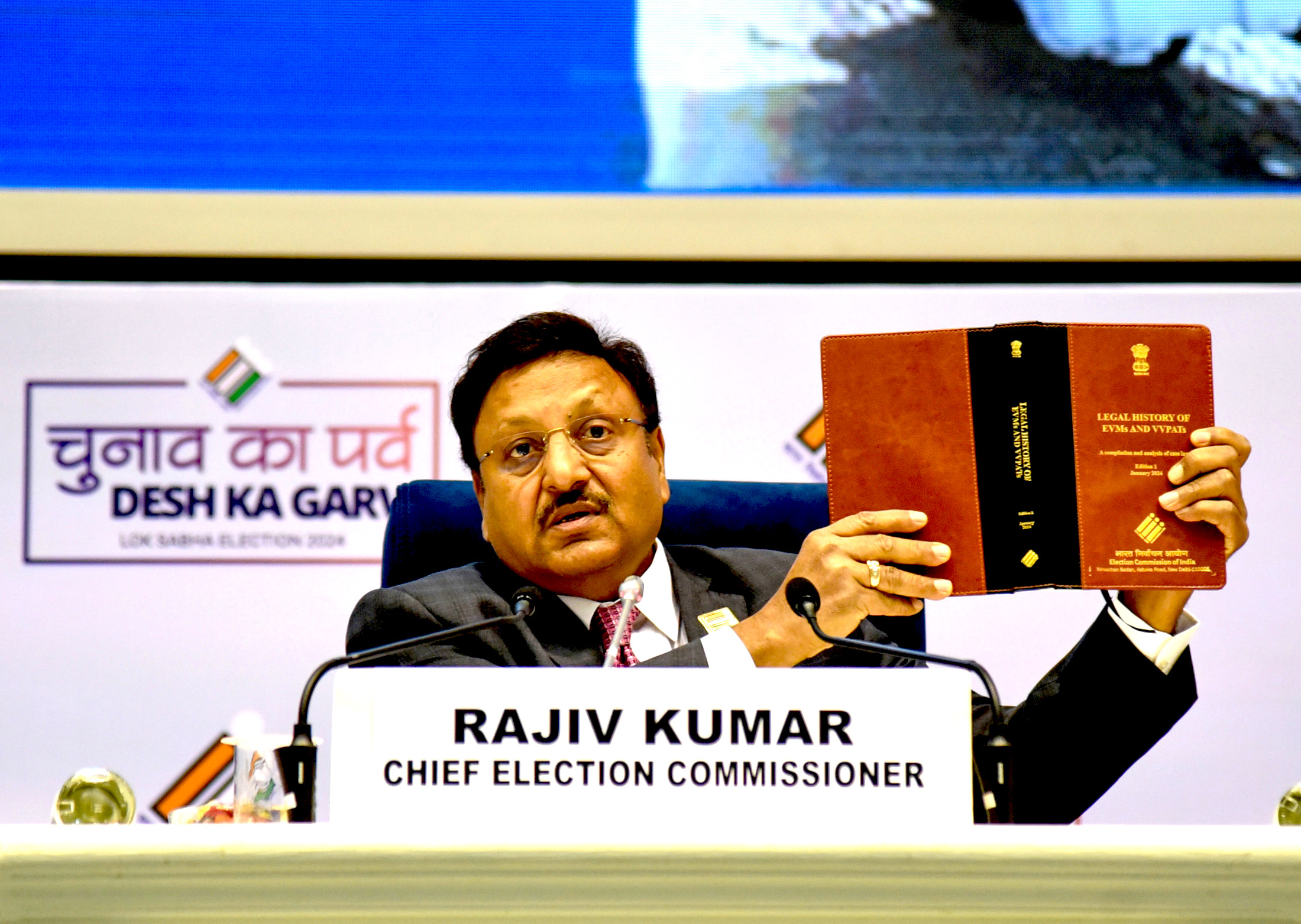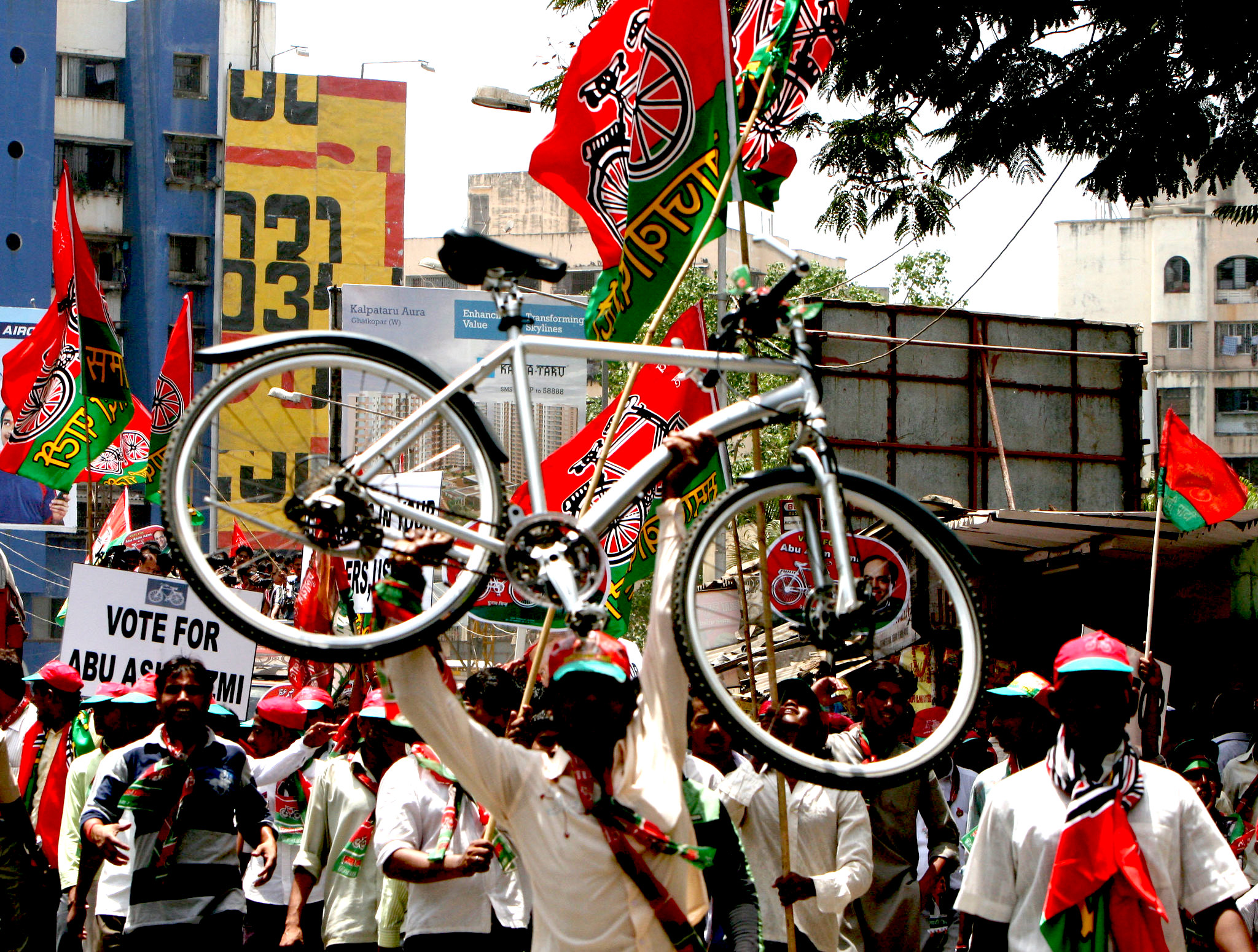The ruling BJP has returned, writes Ullekh NP. But its survival hinges on parties that don’t share its enthusiasm for Hindu nationalism.

PM offers prayers at Sri Venkateswara Swamy Temple in Tirumala, Andhra Pradesh in November 2023. (Prime Minister’s Office of India, Wikiimedia Commons, GODL-India)
By Ullekh NP
Special to Consortium News
 At the height of the mammoth, seven-phased general elections in India spread across six weeks, I came across many rural Indians who liberally used the word tanashaahi, Hindi for dictatorship.
At the height of the mammoth, seven-phased general elections in India spread across six weeks, I came across many rural Indians who liberally used the word tanashaahi, Hindi for dictatorship.
They resented any prospect of an authoritarian rule, democracy in retreat, and indicated that they would vote against any formation seeking to establish an oppressive regime headed by someone excessively power-hungry, a man Plato would call the “beast” of human nature.
It was interesting to hear this concern coming from the common folk of the countryside, often from people who had voted for the ruling Hindu nationalist Bharatiya Janata Party (BJP) five years earlier.
They saw its absolute rule as a cyanide pill to the country’s democratic health, proof that the rural Indian had an ear to the ground and had no sympathy in the long run for politicians sowing social divisions and curtailing democratic freedoms.
Their words contrasted with the announcements of learned pollsters on mass media who predicted a massive landslide for Narendra Modi and a near decimation of the opposition in the polls which saw more than 640 million voters cast their ballots, making it the world’s biggest democratic exercise.
A majority of the so-called exit poll projections, done on the last day of polling on June 1, turned out to be way off the mark. In sharp contrast to those forecasts, the BJP failed to get an absolute majority and requires the backing of its coalition partners to stay in power.
Modi’s BJP and the alliance it leads, the National Democratic Alliance (NDA), had raised the rallying cry for 400-plus seats out of 543 seats in the Lok Sabha, or the lower House of Parliament, to which the elections were held. “Abki Baar 400 Paar” (“This time 400 plus”) was their favorite slogan.
The only time a single party won more than 400 seats was in 1984 in a sympathy wave following the assassination of then Prime Minister Indira Gandhi.
The ruling dispensation has been in a perpetual election mode since Modi came to power in 2014. Notwithstanding token anointments of a few people from disadvantaged groups, it has unabashedly followed a Hindu-first policy for the past decade.
This includes an apparent backing for mobs that targeted those who ate beef, crushing of dissent in universities, destruction of the autonomy of institutes and institutions, and online and offline witch-hunts against Leftist and liberal scholars.
Many BJP politicians also promoted Islamophobia and violence against minorities, passed policies discriminatory towards non-Hindus, and acted against those lowest in India’s caste hierarchy.

On the grounds of India’s Taj-ul-Masjid Mosque, 2018. (Abkshivhare, Wikimedia Commons, CC BY-SA 4.0)
The outcome at the polls was so stark that it threw the BJP into jitters and embarrassed the pliant mainstream media.
Unlike the 2014 and 2019 elections when the BJP enjoyed an absolute majority in the Lok Sabha, meaning it could stay in power on its own, this time around it ran 32 seats short of the 272-mark to gain majority control of the House.
Smarting under an implicit defeat guised as victory, Modi regardless poked fun at the combined opposition on the evening of the announcement of the results on June 4, asserting that together they had fewer seats than the BJP.
But the message was clear to everyone: his party had vastly trailed exit poll results and his expectations of absolute power.
This result came about following a fiercely fought election that saw Modi himself making Islamophobic rants and accusing the Muslims of India of being “infiltrators” and those who “produce more children.”
Although he denied making those specific references later, fact-checkers called him out for such a semantic evasion. He also accused the main opposition Indian National Congress Party — commonly known as Congress — of bringing out a poll manifesto that he said resembled that of the Muslim League (ML).

Congress Party 2024 campaigning kicking off in January in Thoubal, Manipur, India. (Wikimedia Congress, Public Domain)
ML is one of the parties in the opposition I.N.D.I.A bloc, a rainbow coalition that includes Congress and various other parties that came together to fight the BJP’s authoritarian ways.
These parties forged such an alliance against an existential threat after the BJP began engineering splits in various opposition parties and unleashing central agencies against rival politicians to conduct raids on them. They also singled out opposition politicians for criminal investigations and had many of them arrested.
This was why, although the BJP is the single-largest party in Parliament and heads a coalition that has a majority, many have termed this election a loss for Modi but a win for democracy.
Political analyst Yogendra Yadav writes,
“This (2024 election) was the least free and fair national election in the history of independent India, where everything was stacked against the Opposition. Money, media, administrative machine, and what have you — the ruling party enjoyed an infinite advantage over the Opposition.
The Election Commission was blatantly partisan. And yet the people inflicted severe reversals on the ruling establishment. This is reminiscent of the popular mandate against the Congress in 1977, though even then Indira Gandhi had triumphed in the South.”

India’s Chief Election Commissioner Shri Rajiv Kumar during an event in New Delhi to announce the election schedule on March 16, 2024. (Election Commission of India, Wikimedia Commons, GODL-India)
The BJP’s strategy for the past many years has been to focus more on issues that fetched them instant gains in polls and quick acceptance in a polarised electorate rather than on setting things in order.
For instance, while the ruling party has never let go of an opportunity to drive a wedge along religious lines with its statements and actions, it has come under attack for not doing enough to address issues such as unemployment and higher cost of living.
A Lokniti-CSDS survey had shown that unemployment was the primary concern of 27 percent of 10,000 voters across 19 of India’s 28 states. Inflation was second at 23 percent, according to reports.
India’s wholesale price index-based inflation increased by 1.26 percent, year-on-year in April, as against 0.20 percent in February, according to data from the Office of the Economic Advisor, India.
Similarly, official numbers show that the unemployment rate in the country rose to 5.4 percent in 2022-23 from 4.9 percent in 2013-14. Reports quoting official data suggest that as many as 16 percent of urban youth in the age group of 15-29 years remained unemployed in 2022-23 owing to multiple reasons, ranging from poor skills to a lack of quality jobs.
Economists of the stature of Jean Dreze and others had warned about the stagnation of growth in real wages over the past nine years.
But Modi chose to place greater emphasis on temple construction, display of Hindutva credentials and relentless propaganda. His party, which prides itself in mastering the art of winning elections, hastened to project the polls as a presidential-style contest in which Modi was seen as unbeatable.
The Congress Party, which had won only 42 seats in 2014 and 52 in 2019 appeared weak in comparison with the BJP, which had won 282 and 303 respectively.
Placing temple-building at the center of governance gave rise to fears that any such Hindutva revivalism would strengthen India’s age-old and dreaded caste hierarchy.
Perhaps the BJP could learn a lesson or two from the reverses it incurred in parliamentary seats reserved for the Scheduled Castes (SCs) and the Scheduled Tribes (STs): of the 92 seats it lost this time compared with 2019, 29 were reserved for SCs and STs, a fall in support from these communities compared with the previous two general elections.
In the crucial state of Uttar Pradesh, which sends 80 members to the Lok Sabha, the BJP had anticipated winning almost all the seats. But it suffered a rout, shrinking to 33 seats this time, from 62 in 2019. Samajwadi Party (SP), the regional party that is vehemently anti-Hindutva, won 37 seats while the Congress Party won six of its 100 nationwide seats from Uttar Pradesh.

A Samajwadi Party supporter carries a bicycle – the symbol which adorns the socialist party’s flag, April 2009. (Al Jazeera English, Flickr, CC BY-SA 2.0)
The most embarrassing defeat for the BJP in Uttar Pradesh was in the seat of Faizabad, which represents the holy city of Ayodhya.
Modi had, earlier this year, played the role of the chief priest in the widely publicized consecration of a new temple dedicated to Lord Ram. The temple has been built on the site of a medieval-era mosque, which was demolished in 1992 by Hindu nationalists.
The incumbent BJP candidate from that constituency, Lallu Singh, had appealed to people during a poll campaign to give the BJP a two-thirds majority in Parliament so that they could write a new Constitution for India.
Not only did this suggest that the secular nature of the country would be amended, it was also perceived as a slight on one of the key architects of the Indian constitution, Dr. BR Ambedkar, who was a Dalit, previously known as “untouchable.”
Modi himself trailed his victory margins of 2014 and 2019 in Varanasi, considered by Hindus as the holiest of holy cities. His vote share fell by more than 9 percent, winning by a margin of 152,513 votes compared with 479,505 five years ago.
The election results, therefore, came as a rude shock to BJP, and as a check to Modi’s vaulting ambitions.
Worse, he is now reliant on allies, especially N Chandra Babu Naidu of the Telugu Desam Party (TDP) and Nitish Kumar of Janata Dal (United). Both are veteran political players who can easily wear out anyone as unused to the pressures of coalition politics.
As of now, Modi’s days of unilateral decisions appear to be over.
Ullekh N.P. is a writer, journalist, and political commentator based in New Delhi. He is the executive editor of the newsweekly Open and author of three nonfiction books: War Room: The People, Tactics and Technology Behind Narendra Modi’s 2014 Win, The Untold Vajpayee: Politician and Paradox and Kannur: Inside India’s Bloodiest Revenge Politics. His forthcoming book on Cuba, part travelogue and part political commentary, is due for release in November 2024.
Views expressed in this article and may or may not reflect those of Consortium News.
Please Donate to the
Spring Fund Drive!



Now, let’s not forget Kashmir. Still awaiting that promised plebiscite since 1948.
That will happen once Pakistan stops sponsoring cross-border terrorism and the genocide of Kashmiri Pandits at the hands of radical Islamists ends and they can earn the right to return to their homes. Pakistan hasn’t wanted that for obvious reasons and the much needed development of the state is a further threat to them.
Kashmir is under an occupation whose brutality can be compared with that of Israel in the West Bank, complete with the all too familiar tools of military violence, torture and humiliation. Arundhati Roy spoke movingly of Kashmir in a lecture in New York and wrote about it in the Nation. Here are the respective links:
hxxps://youtu.be/fnpOpO9NCGk
hxxps://www.thenation.com/article/world/arundhati-roy-assam-modi/
Finally, some unabashedly good news in the electoral world. Well done, India!
Agreed. No man is a God on Earth and a functioning Democracy requires a vibrant opposition. Modi managed to ensure the BJP remains the largest/most popular party by a margin, moved into the Eastern coastal belt state of Orissa with a sweeping majority for the first time, gained a toe-hold in the southernmost state of Kerela for the first time in its history and swept the Capital region, home to the upstart AAP party there. It has a lot going for it and the biggest mistake India’s opposition parties can make is to assume the ruling party is weak. The title of this article sums it up.
Modi needs to go! Power to the People!!